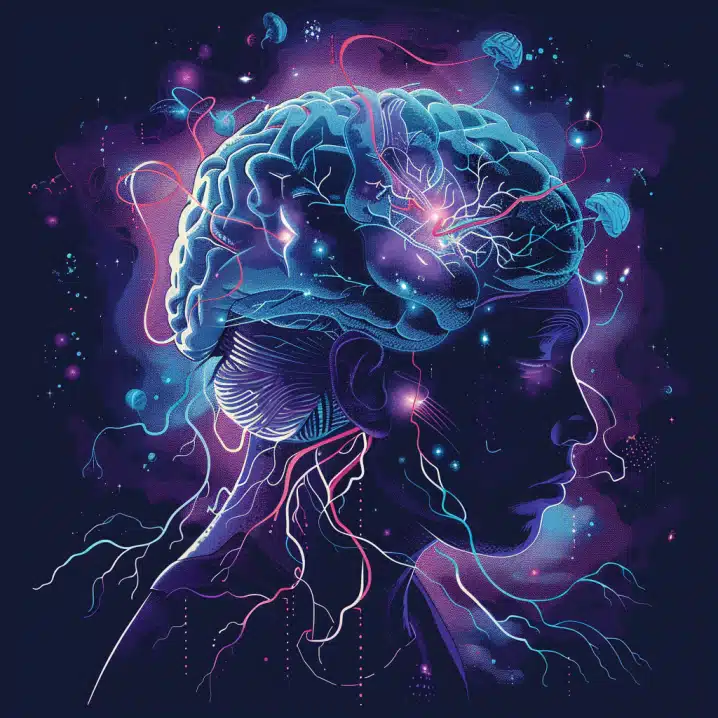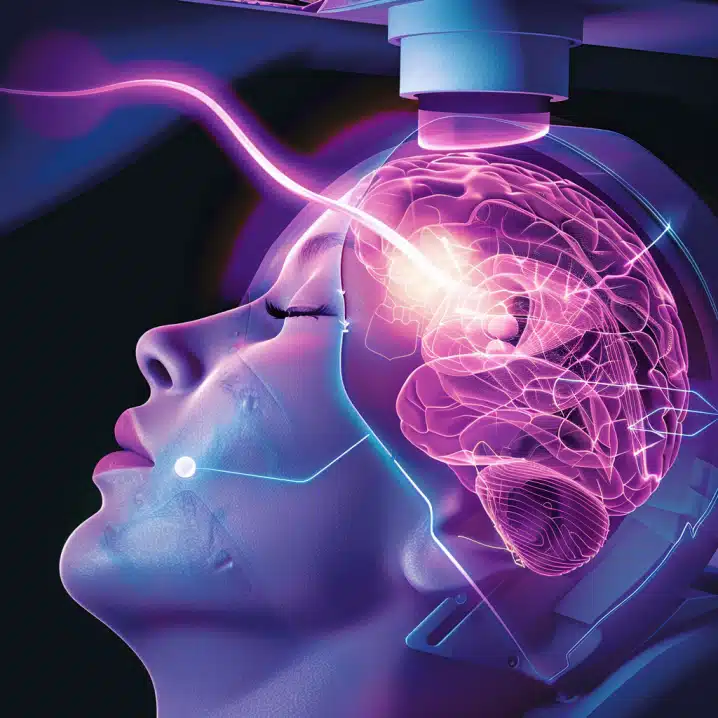Transcranial Magnetic Stimulation (TMS) has emerged as a beacon of hope in the realm of psychiatry, offering a non-invasive alternative for treating psychiatric disorders. The variability in treatment outcomes highlights the necessity for advancements in personalized approaches.
A recent paper analyzed the potential of personalized TMS protocols (customized based on individual brain connectivity) may help treat psychiatric disorders and play a role in the future of psychiatry.
Highlights:
- Transcranial Magnetic Stimulation (TMS) is a non-invasive procedure approved by the FDA for treating major depressive disorder and has potential benefits for other psychiatric conditions.
- Individual Functional Connectivity (FC) analysis provides a personalized map of a person’s brain connections, offering a more targeted approach for TMS therapy.
- Challenges such as low signal-to-noise ratio (SNR) in individual FC measurements can hinder the precise targeting of TMS but can be mitigated by extending scan durations and employing clustering methodologies.
- Recent studies using the Human Connectome Project dataset demonstrate the feasibility of achieving stable personalized TMS targets, suggesting a path toward more effective and individualized psychiatric treatments.
Source: Frontiers in Psychiatry (2024)
Personalized Transcranial Magnetic Stimulation (TMS)
Personalized Transcranial Magnetic Stimulation (TMS) represents a tailored approach to neuromodulation therapy, wherein treatment parameters, including the stimulation site, are customized based on the individual’s unique brain functional connectivity (FC).
Unlike traditional TMS, which often relies on standardized scalp locations for targeting, personalized TMS utilizes advanced imaging and analysis techniques to identify the most effective stimulation points specific to each patient’s neural architecture.
How Does It Work?
- Assessment of Individual FC: Personalized TMS begins with a comprehensive analysis of the patient’s brain using resting-state functional magnetic resonance imaging (rsfMRI). This imaging technique captures the brain’s activity patterns at rest, providing detailed insights into the interconnectedness of various brain regions.
- Identification of Pathological Networks: By analyzing the rsfMRI data, researchers and clinicians can identify the specific neural networks associated with psychiatric disorders, such as major depressive disorder (MDD) or schizophrenia with auditory verbal hallucinations (AVH).
- Optimization of TMS Targeting: Leveraging individual FC data, the optimal site for TMS application is determined. This process involves computational models that consider the unique connectivity patterns of the patient’s brain, aiming to target the pathological network most effectively.
- Application of Advanced Methodologies: To address challenges like the low signal-to-noise ratio (SNR) in individual FC measurements, strategies such as extending scan durations and employing spatial cluster methods are utilized. These techniques enhance the precision of FC analysis, thereby improving the accuracy of TMS targeting.
(Related: Customized TMS for Psychiatric Disorders Based on Neuroimaging Data)
Major Findings: Personalized Network Targeting with TMS in Major Depression & Schizophrenia (2024)
Cao et al. sought to evaluate the stability and efficacy of a personalized network targeting model for Transcranial Magnetic Stimulation (TMS) treatment, focusing on individuals with major depressive disorder (MDD) or schizophrenia with auditory verbal hallucinations (AVH).
Utilizing resting-state functional magnetic resonance imaging (rsfMRI) data from the Human Connectome Project, the research incorporated advanced methodologies to improve the precision of individual functional connectivity (FC) and, consequently, TMS targeting – below are the major findings.
1. Enhancement of Personalized TMS Targeting through Individual FC
The study illuminates a critical shift from using generalized, group-averaged functional connectivity (FC) maps to employing individualized FC in determining TMS targets.
Traditional methods often rely on a “one-size-fits-all” approach, using standardized brain maps that may not reflect the unique neural configurations of each individual.
In contrast, individual FC provides a detailed blueprint of a person’s specific neural connections and activities.
This approach allows for the identification of stimulation sites that are optimally positioned to influence the neural networks directly implicated in an individual’s disorder.
By targeting these precise areas, personalized TMS aims to directly modulate the dysfunctional networks responsible for psychiatric symptoms, potentially enhancing therapeutic outcomes by ensuring the magnetic fields more accurately affect the intended areas of the brain.
2. Methodological Strategies to Counter Low SNR in Individual FC
The granularity of individual FC comes with its challenges, notably the low signal-to-noise ratio (SNR) of rsfMRI data.
Low SNR can blur the distinction between genuine neural signals and background noise, complicating the accurate mapping of functional brain connectivity.
To address this, the study employed two innovative strategies: extending the duration of rsfMRI scans and applying spatial clustering techniques.
Extending scan durations to 28 minutes allows for a more robust and comprehensive capture of brain activity over time, thereby enhancing the SNR and the reliability of FC measurements.
Simultaneously, clustering methodologies group together similar activation patterns, mitigating the impact of random noise by focusing on consistent, reproducible patterns of brain activity.
These combined strategies significantly improve the precision with which TMS targets can be identified, making it a cornerstone for reliable personalized TMS targeting.
3. Achievement of Stable Identification of Individual TMS Sites
One of the study’s key achievements is demonstrating the feasibility of consistently identifying individual-specific TMS targets with high precision.
By integrating extended scan durations and clustering methods, the researchers effectively countered the variability inherent in individual FC analysis.
This led to the identification of TMS targets with intraindividual distances that fall within the spatial resolution capability of TMS technology (~1cm).
Achieving such precision is crucial for ensuring that TMS can be accurately and consistently applied to the intended brain regions across different treatment sessions, significantly advancing the goal of personalized neuromodulation therapy.
4. Validation of the Personalized FC-Based Network Targeting Model
The personalized FC-based network targeting model underwent validation within the contexts of major depressive disorder (MDD) and schizophrenia with auditory verbal hallucinations (AVH).
Utilizing two-day rsfMRI scans, the study meticulously assessed the model’s ability to maintain stability across these conditions, focusing on parameters such as the stimulation network, network targeting accuracy (NTA) map, and intraindividual site consistency.
The outcomes reaffirmed the model’s effectiveness in pinpointing optimal TMS targets, thus confirming its potential as a viable and clinically applicable approach for personalizing TMS therapy.
This validation marks a significant step forward in translating advanced neuroimaging and computational methodologies into practical tools for improving mental health treatments.
5. Feasibility Across Different Psychiatric Disorders
Perhaps one of the most promising aspects of this research is the model’s applicability to a broad spectrum of psychiatric disorders.
The study’s findings suggest that this personalized approach, rooted in individual FC analysis, is capable of accurately targeting the neural networks associated with both MDD and schizophrenia with AVH.
This versatility underscores the potential for expanding personalized TMS to other conditions, offering a new horizon for treatment strategies that are finely tuned to the diverse and complex landscape of psychiatric illnesses.
By enabling targeted modulation of disorder-specific pathological networks, personalized TMS holds the promise of ushering in a new era of more effective and customized psychiatric care.
(Related: Stanford Accelerated Intelligent Neuromodulation Therapy for Rapid Treatment of Suicidal Depression)
Functional Connectivity (FC) Network Targeting with TMS for Depression & Schizophrenia (2024 Study)
The primary aim of this study was to evaluate the stability of a personalized Functional Connectivity (FC)-based network targeting model for individuals with major depressive disorder (MDD) or schizophrenia with auditory verbal hallucinations (AVH).
The study sought to determine the optimal Transcranial Magnetic Stimulation (TMS) coil settings that would engage the functional pathway delivering stimulation, thereby improving the efficacy of TMS treatment for psychiatric disorders.
Methods
- The study utilized resting-state functional magnetic resonance imaging (rsfMRI) data from the Human Connectome Project to assess the model’s stability.
- It employed longer scan durations and cluster methodologies to enhance precision in identifying optimal individual sites for TMS.
- Participants included cohorts from the HCP-young adult dataset, resulting in a total of 134 participants.
- The rsfMRI data underwent several preprocessing steps including slice timing correction, head motion correction, and spatial smoothing, among others.
- For MDD and schizophrenia AVH, personalized Network Targeting Accuracy (NTA) maps were calculated using individualized FC and specific cranial search spaces.
- The study utilized SimNIBS 3.2 for segmenting T1 images and generating individual parameter spaces.
- The stability was evaluated using three indices: intrasession stimulation network similarity, intrasession NTA map similarity, and intraindividual distance.
Findings
- Increased Scan Duration & Stability: Extending the rsfMRI scan duration to 28 minutes improved the stability of the personalized FC-based network targeting model. The intrasession stimulation network similarity and NTA map similarity indices demonstrated increased stability with longer scan durations.
- Cluster Method Efficacy: Employing the cluster method significantly enhanced the stability of identifying optimal individual sites, with the intraindividual distance falling below the ~1cm spatial resolution of TMS.
- Feasibility of Personalized TMS Targets: The study confirmed the feasibility of obtaining stable personalized TMS targets from the scalp, which could lead to more accurate TMS targeting in clinical applications.
Limitations
- Practical Implementation: The longer scan durations required for improved stability may pose practical challenges in clinical settings, where time and resources are limited.
- Generalizability: The study’s findings are based on data from the Human Connectome Project, and further research is needed to validate these findings across diverse populations and psychiatric conditions.
- Retrospective Validation Needed: Although the model demonstrated potential, retrospective validation is necessary to confirm its clinical utility.
- Focus on Specific Disorders: The study specifically targeted MDD and schizophrenia with AVH. The applicability of the model to other psychiatric or neurological conditions remains to be explored.
(Related: Symptom Provocation in Psychiatric Disorders)
Personalized TMS vs. Conventional TMS (Comparison)
Conventional TMS: The Standard Approach
Conventional Transcranial Magnetic Stimulation (TMS) is a non-invasive procedure used to modulate neural activity in the brain, primarily for treating psychiatric disorders such as depression.
The traditional method involves targeting standardized scalp locations based on general landmarks or average brain maps.
These locations, such as the dorsolateral prefrontal cortex (DLPFC), are chosen based on their association with specific disorders and their responsiveness to magnetic stimulation in clinical studies.
However, this one-size-fits-all approach does not account for individual differences in brain anatomy or functional connectivity, potentially leading to variability in treatment outcomes.
Personalized TMS: A Tailored Approach
Personalized TMS, on the other hand, represents a more nuanced and individual-centered approach to neuromodulation therapy. This method involves several key differences and advancements over its conventional counterpart:
Individualized Targeting: Personalized TMS utilizes advanced neuroimaging techniques, such as resting-state functional magnetic resonance imaging (rsfMRI), to map the unique neural connections and functional architecture of an individual’s brain. This allows for the identification of optimal stimulation sites that are specifically tailored to the patient’s neural landscape.
Enhanced Precision: By targeting areas of the brain based on individual functional connectivity (FC), personalized TMS can more accurately modulate the neural networks associated with psychiatric disorders. This precision aims to engage the pathological network more effectively, enhancing the therapeutic impact of the treatment.
Adaptability: Personalized TMS offers the flexibility to adapt treatment strategies to the specific needs and conditions of each patient. This adaptability is crucial for addressing the wide variability in brain structure and function seen across the population.
Improved Efficacy & Safety: The tailored approach of personalized TMS has the potential to not only improve treatment efficacy but also reduce the incidence of side effects. By focusing magnetic stimulation on precisely identified targets, it minimizes the risk of inadvertently affecting non-targeted brain regions.
Data-Driven Methodologies: Personalized TMS incorporates advanced data analysis and computational modeling to interpret individual FC data. Strategies such as extending scan durations and employing spatial clustering techniques are used to overcome challenges like low signal-to-noise ratios, enhancing the stability and reliability of the targeting process.
Advantages of Personalized vs. Conventional TMS
The primary advantage of personalized TMS over conventional TMS lies in its patient-centric approach, which acknowledges the unique neural signatures of each individual.
This recognition of individual differences ensures that treatment is not only more effective but also safer, with a lower likelihood of side effects.
Additionally, the data-driven nature of personalized TMS offers insights into the underlying mechanisms of psychiatric disorders, further informing treatment strategies and potentially leading to breakthroughs in neuropsychiatric research.
While conventional TMS has been a cornerstone in the treatment of psychiatric disorders, personalized TMS represents the next evolution in neuromodulation therapy.
By integrating advanced imaging and computational techniques, personalized TMS offers a more effective, safer, and tailored approach to treating the complex landscape of psychiatric conditions.
Conclusion: Personalized TMS for Psychiatric Disorders
References
- Paper: Personalized connectivity-based network targeting model of transcranial magnetic stimulation for treatment of psychiatric disorders: computational feasibility and reproducibility (2024)
- Authors: Zhengcao Cao et al.


